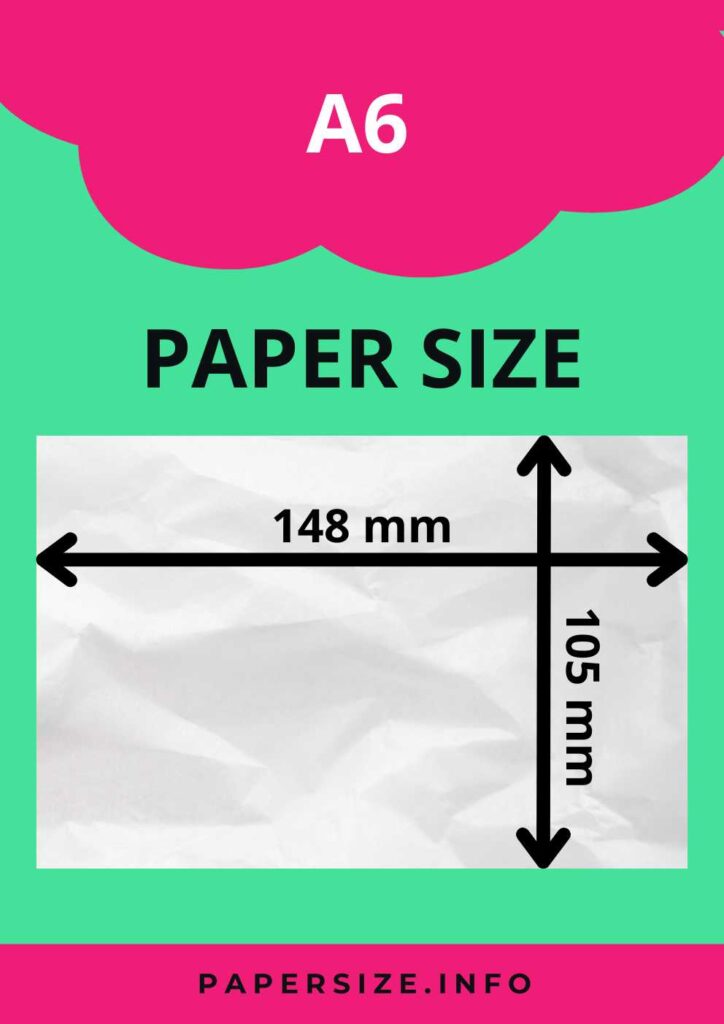A6 Paper Size and Dimensions

A6 paper size, A6 sheet size, A6 paper size in mm, cm, meter, inches and feet. All A6 paper size data in one place
The A6 paper size is recognized under the ISO standard system and is commonly used throughout Europe and most of the world, with the exceptions of North America, certain regions of South America, and the Philippines. As a part of the A series of paper sizes, A6 plays an important role in the standardized system that simplifies paper sizing globally.
In terms of size relationships within the A series, an A6 sheet is precisely twice as large as an A7 sheet and exactly half the size of an A5 sheet. This hierarchical scaling ensures that resizing documents up or down within the A series is seamless and efficient, preserving the content’s proportions and layout integrity. A6 is particularly favored for smaller printed materials such as postcards, small brochures, and personal notepads, where a compact format is ideal for portability while still providing sufficient space for essential information.
A6 Paper Size Dimensions
Here are the specific dimensions of a sheet of A6 paper, provided in different units of measurement:
- A6 paper size in millimeters: 148 mm x 105 mm.
- A6 paper size in centimeters: 14.8 cm x 10.5 cm.
- A6 paper size in inches: 5 7/8 by 4 1/8 inches.
These measurements align with the ISO standard for paper sizes, ensuring that A6 paper is widely compatible for a range of uses across different countries, except in places like North America, some parts of South America, and the Philippines where different standards may be used. The A6 size is ideal for smaller-scale documents such as postcards, flyers, and personal notepads, offering enough space for essential information while remaining compact and easy to handle.
Area of One Sheet of A6 Paper
The area of one sheet of A6 paper, like other sizes in the A series, is systematically derived based on the area of an A0 sheet, which is exactly 1 square meter. This structured approach ensures that each subsequent size in the series is a direct fraction of A0, providing consistency and ease of understanding across the different paper sizes.
Area of One Sheet of A6 Paper:
- Square Meters: 0.0156 sq m (exactly 1/64 of a square meter)
- Square Inches: 24.087 sq in
- Square Feet: 0.1673 sq ft
This method of defining paper sizes by area allows for straightforward scaling and resizing of documents, preserving the aspect ratio and ensuring accuracy in content layout and design. The compact size of A6 is particularly suited for smaller print items such as postcards and small flyers, where a smaller paper size is adequate for the information and still easy to handle and distribute.
A6 Size in Pixels
When planning to print designs onto A6 paper, determining how many pixels the design should be is a common concern. The exact pixel dimensions for A6 paper can vary depending on the resolution of your printing device or display, measured in dots per inch (DPI).
Understanding DPI and Its Impact:
DPI, or “dots per inch,” is a measure of how many pixels will be printed or displayed per inch. This resolution varies significantly across different devices:
- Monitors: Commonly between 100 and 120 DPI, debunking the myth of the standard 72 DPI.
- Home or Office Printers: Typically operate at around 300 DPI.
- Professional Printing Services: Resolution can range from 250 DPI to 600 DPI, with some high-end printers offering up to 1200 DPI for extremely high-quality outputs.
Pixel Dimensions for A6 Size:
Given the variability in DPI settings, here are some approximate pixel dimensions for an A6 sheet at different resolutions:
- 96 DPI: 559 x 397 pixels
- 100 DPI: 583 x 413 pixels
- 120 DPI: 699 x 496 pixels
- 300 DPI: 1748 x 1240 pixels
- 600 DPI: 3496 x 2480 pixels
Importance of Choosing the Right DPI:
When preparing to print a design on A6 paper, knowing the specific DPI setting of your printer or display is crucial to ensure that the final output aligns with your expectations. Selecting the appropriate DPI is essential for achieving the desired clarity and detail in the printed design. Higher DPI settings result in sharper and more detailed images but require files with more pixels, which can increase file size and potentially impact printing speeds and costs.
Practical Considerations:
Before initiating a design project intended for A6 printing, confirm the DPI settings of the printing service or device you plan to use. This preparation allows you to create a design with the optimal number of pixels, ensuring that the dimensions of your digital image precisely match the physical size of the A6 paper. This attention to detail helps prevent issues such as image stretching or pixelation, ensuring high-quality print results.

